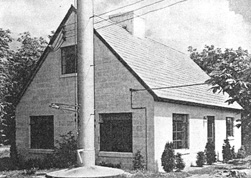|















©
1999-2025
Man From Mars Productions

|
| |

Click
for enlargement
|
November
24, 1930 - WDRC closed its studios at the Hotel
Taft in New Haven and moved the equipment to Hartford.
December
5, 1930 - At 5:00PM, WDRC greeted its new audience
with live music programs from studios in the Corning Building at
11 Asylum Street. The transmitter was housed at 783
Blue Hills Avenue in nearby Bloomfield. WDRC became the
76th affiliate of the CBS Radio Network.
December
11, 1930 - CBS officially welcomed WDRC to its
roster with a nationwide hookup from 10:30-11:30PM. Governor John
H. Trumbull and Hartford Mayor Walter E. Batterson were among the
speakers. The Guy Lombardo and Ben Bernie orchestras were featured
performers.
March,
1931 - The licensee name was changed from Doolittle Radio
Corporation to WDRC Incorporated.
June,
1933
- Franklin M. Doolittle
asked the Federal Radio Commission for authority to increase power
from 500 to 1,000 watts. He submitted a detailed financial statement
indicating WDRC made a net profit of $34,787.96 in 1932 on
its investment of $5,000.
September
23, 1933 - Power was increased to 1,000 watts.
|

The Hartford Daily Times,
Tuesday, December 2, 1930, p.23 |
|
| |

Aerial
shot of WDRC's building at 750
Main Street in Hartford; Traveler's
Tower is to the right
Click
for photos of 1936 studios
|
February
13, 1934 - A routine FRC license renewal application
revealed that WDRC Incorporated was owned as follows: New
Haven Broadcasting Co., of Hartford, 50%; Sam
Pickard, of Rye, NY, 22.4%; Lawrence
W. Lowman, of New York, 22.4%. Pickard and Lowman were both
CBS vice presidents.
April
27, 1934 - The FRC authorized an increase to 2,500 watts
day, 1,000 watts night.
October,
1934 - A new transmitting station was built at 785
Blue Hills Avenue in Bloomfield, 40 feet from the original structure.
December,
1935 - The station began utilizing a new 310-foot tower
at the Bloomfield transmitter site. Click
for photo; note 3 towers.
 |
(Left)
What
every well-dressed 1934 Plymouth needed - a WDRC license plate
frame!
(Right)
Kate
Smith newspaper ad: October 1, 1935.
January
10, 1936 - Daytime power was increased to 5,000
watts.
|
March,
1936 - New England sustained $100 million damage in a
series of deadly floods. WDRC provided coverage by candlelight when
heat and lights went out in downtown Hartford. Click
for a photo of 1936 flood coverage.
1936 - Doolittle received permission to operate W1XSL,
one of twelve "Apex" AM high frequency stations on an
experimental basis. It was built on the west peak of Meriden Mountain
and operated at 40,300kc (40.3mc) with 1kw of power.
May
16, 1936 - WDRC moved from 11 Asylum Street to
new studios in the 16th floor penthouse of the Hartford Trust Company
(later Connecticut Bank & Trust) building at 750
Main Street in Hartford.
|

The Hartford Courant, October 1, 1935
|
|
| |
|
September
1936 - WDRC featured Joseph Blume and his
Famous Blue Room Ensemble. Click on ad (right) for
a larger view. Blume's son, Jerry,
would be a staff announcer from 1959-63.
September
14, 1937 - Bloomfield renumbered Blue
Hills Avenue so WDRC's transmitter property became #869.
January
26, 1938 - W1XSL changed its name to W1XPW.
mid
1938 - WDRC operated daily from 7:00AM to
1:00AM. It's slogan was "The Advertising Test Station in
the Advertising Test City."
For a
display of WDRC logos
over the decades click on the image to the right.
|


The
Advertising Test Station in
the Advertising Test City
|

Orson
Welles |
October
30, 1938 - The station aired what became one of
the most infamous broadcasts of all time - The Mercury Theater's
production of War of the Worlds on CBS. Directed by,
and starring, Orson Welles, the hour-long drama about an imaginary
invasion of New Jersey by Martians genuinely terrified the
nation.
The front
page of the next morning's Hartford Courant detailed
the extent of the local reaction but never mentioned WDRC
by name. The article merely said: "Upon learning from
a local broadcasting company that it was a play, [a Courant
telephone operator] repeatedly explained it to callers,
but in many cases so frenzied was the hysteria, she was unable
to convince them it was fictional and not real."
Click
to read more about War of the Worlds.
|
|
January
9, 1939 - The FCC granted WDRC's application
to use a 100 watt transmitter developed by Dr. Edwin H. Armstrong
to conduct tests of ultra high frequency modulation. The authorization
included tests from 86,000 to 400,000 k.c. and frequency width
up to 200 k.c.
May
13, 1939 - At a cost of $20,000, Doolittle put
America's first commercial FM station on the air at 2:39PM,
as experimental station W1XPW. It was on the air from
3PM-12M, airing classical music, and later simulcasting WDRC.
All FM promotion and production was supervised by announcer
Bob Provan (right).
October
1939 - W1XPW began operating on a regular
schedule at 43.4 MHz. The transmitter and 90 foot steel mast
were atop Meriden Mountain (elevation
1,000 feet).
|
|
|

Click
for photos of Meriden Mountain
|
November
27, 1939 - The Federal Communications Commission
approved an AM power increase to 5,000 watts day and night;
construction on a multi-tower directional array began.
late
1939 - Announcer Jack
Zaiman read a sportscast over W1XPW. It was relayed,
without wires, to FM stations in Albany, then to Schenectady,
then back to Hartford, all without static. No one heard the
broadcast except for the engineers at each station because
there were few FM sets in use.
December
4, 1939 - W1XPW participated in another
frequency modulation triple rebroadcast. W2CR in Yonkers,
NY broadcast a program which was picked up and rebroadcast
by Major Edwin H. Armstrong's station W2MN in Alpine, NJ,
then picked up and rebroadcast a third time over WDRC's
FM sister station atop Meriden
Mountain.
|
|
|
|











